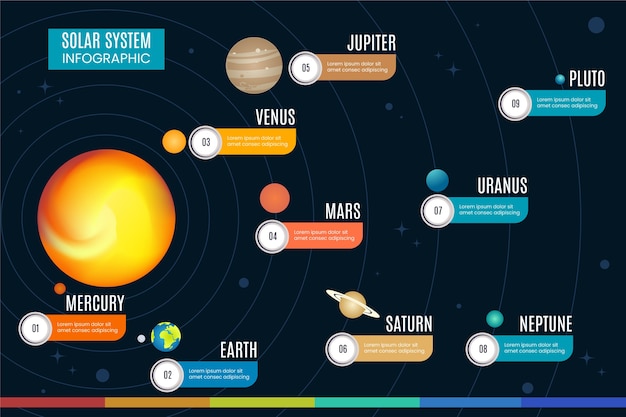Jupiter – Unveiling the Fascinating Facts

Jupiter is the largest planet in our solar system.
Jupiter has a strong magnetic field that is 14 times stronger than Earth’s.
Jupiter has a unique feature called The Great Red Spot, which is a giant storm that has been raging for over 300 years.
Jupiter is composed mostly of hydrogen and helium gases.
Jupiter has 79 known moons, with the four largest being Io, Europa, Ganymede, and Callisto.
Jupiter’s gravity is so strong that it can capture asteroids and comets in its orbit.
Jupiter plays a crucial role in protecting Earth by deflecting many potentially dangerous comets and asteroids away from our planet.
Jupiter’s fast rotation causes it to have an oblate shape, with the poles being slightly flattened and the equator bulging out.
Jupiter is the third-brightest natural object in the night sky after the Moon and Venus.
Jupiter’s atmosphere is composed mainly of hydrogen and helium, with small amounts of methane, ammonia, water vapor, and other compounds.
Jupiter’s famous bands of clouds are actually composed of ammonia crystals.
When Galileo Galilei first observed Jupiter through a telescope, he discovered its four largest moons, now known as the Galilean moons.
Jupiter’s largest moon, Ganymede, is the largest moon in the solar system and is even bigger than the planet Mercury.
Jupiter experiences the most intense radiation of any planet in our solar system.
Jupiter – Unveiling the Fascinating Facts part 2
Jupiter has a unique feature called oval BA, a giant storm that was formed when three smaller storms merged together.
Jupiter’s equatorial region has a swirling pattern known as the South Equatorial Belt, which is formed by powerful jet streams.
Jupiter’s magnetic field is so powerful that it creates a hazardous radiation belt surrounding the planet.
Jupiter has a faint ring system made up of small, dark particles.
The temperatures on Jupiter can range from -145 degrees Celsius (-234 degrees Fahrenheit) to over 1,100 degrees Celsius (2,012 degrees Fahrenheit).
Jupiter is often referred to as a failed star because it lacked the mass needed to ignite nuclear fusion.
Jupiter is so massive that it significantly affects the orbits of other planets in the solar system.
If Jupiter were hollow, it could fit more than 1,300 Earths inside it.
Jupiter has been visited by several spacecraft, including the Pioneer 10, Pioneer 11, Voyager 1, Voyager 2, Galileo, and Juno missions.
Jupiter’s magnetic field creates beautiful auroras near its poles, just like Earth.
Jupiter’s core is believed to be made up of heavy elements like rock and metal.
Jupiter’s fast rotation causes it to have a day that is less than 10 hours long.
Jupiter’s unique coloration is caused by different chemical compounds in its atmosphere, including sulfur and phosphorous.
Jupiter is named after the king of the gods in Roman mythology.
Jupiter’s gravity is so strong that it can cause tidal forces on its moons, leading to volcanic activity on some of them.
Jupiter has an intricate and ever-changing cloud pattern that is constantly shifting and evolving.
Jupiter’s strong magnetic field creates intense auroras that can be seen even from Earth using powerful telescopes.
Jupiter’s moon Europa is believed to have a subsurface ocean of liquid water, making it a potential habitat for life.
Jupiter has a faint radiation belt known as the innermost radiation belt that orbits close to the planet.
Jupiter’s largest moon, Ganymede, has its own magnetic field, making it the only moon in the solar system with such a feature.
Jupiter has been visited by more space missions than any other planet in our solar system.
Jupiter’s strong gravity causes atmospheric pressure to increase dramatically with depth.
Jupiter’s rapid rotation causes it to have a prominent equatorial bulge.
Jupiter’s moon Io is the most volcanically active object in our solar system, with hundreds of active volcanoes.
Jupiter’s atmosphere contains powerful storms and lightning activity.
Jupiter’s gravitational forces have shaped the orbits of other planets and asteroids in the solar system over billions of years.
Jupiter has a unique feature called string of pearls, a series of white oval-shaped storms in its atmosphere.
Jupiter’s powerful magnetic field creates a vast magnetosphere that extends far beyond the planet itself.
Jupiter emits more heat than it receives from the Sun, indicating that it has its own internal heat source.
Jupiter’s atmospheric features, such as its bands and storms, can change and evolve over time.
Jupiter’s immense size and mass make it the dominant object in the region of the solar system where it resides.

